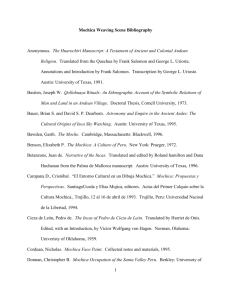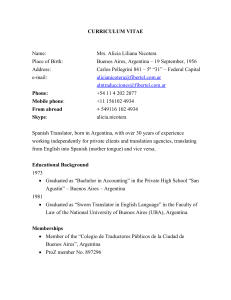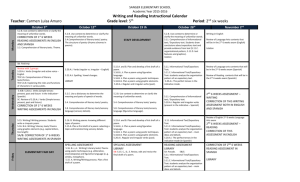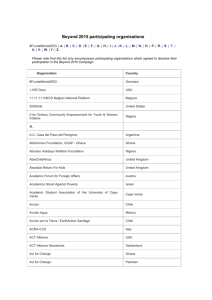ISBN: 978-90-429-2228-0
advertisement
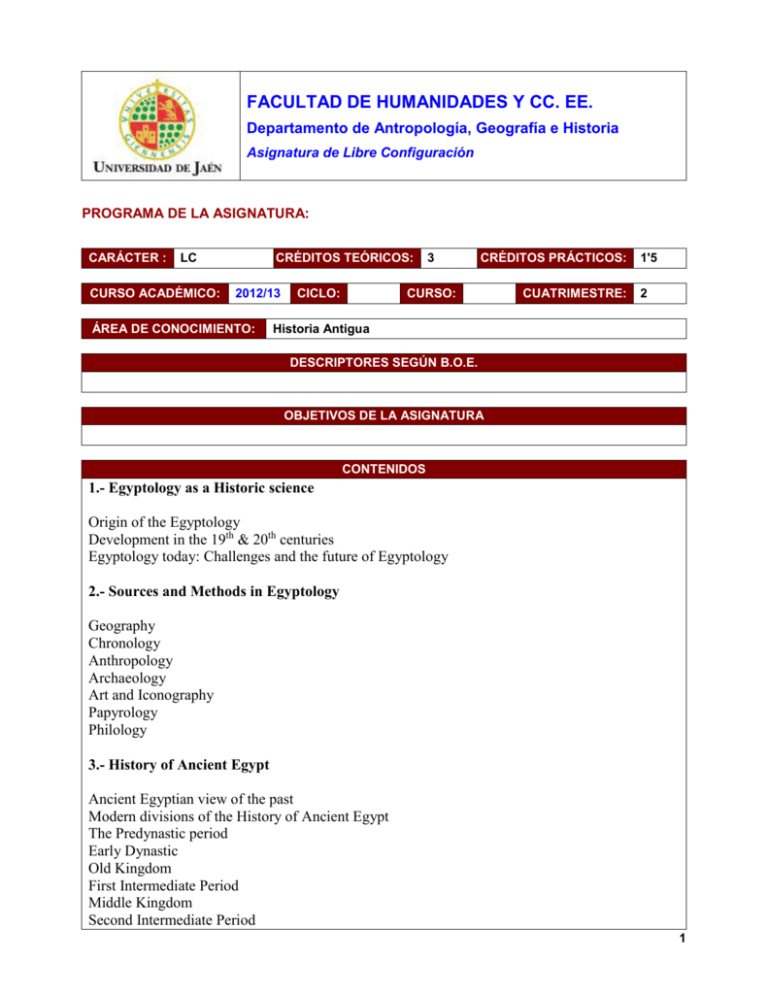
FACULTAD DE HUMANIDADES Y CC. EE. Departamento de Antropología, Geografía e Historia Asignatura de Libre Configuración PROGRAMA DE LA ASIGNATURA: CARÁCTER : LC CURSO ACADÉMICO: CRÉDITOS TEÓRICOS: 2012/13 ÁREA DE CONOCIMIENTO: CICLO: 3 CRÉDITOS PRÁCTICOS: CURSO: CUATRIMESTRE: 1'5 2 Historia Antigua DESCRIPTORES SEGÚN B.O.E. OBJETIVOS DE LA ASIGNATURA CONTENIDOS 1.- Egyptology as a Historic science Origin of the Egyptology Development in the 19th & 20th centuries Egyptology today: Challenges and the future of Egyptology 2.- Sources and Methods in Egyptology Geography Chronology Anthropology Archaeology Art and Iconography Papyrology Philology 3.- History of Ancient Egypt Ancient Egyptian view of the past Modern divisions of the History of Ancient Egypt The Predynastic period Early Dynastic Old Kingdom First Intermediate Period Middle Kingdom Second Intermediate Period 1 New Kingdom Third Intermediate Period Late Period Graeco-Roman Egypt The neighbouring regions Nubia The surrounding deserts Canaan and Palestine Mesopotamia Anatolia Aegean 4.- Writing and Language Egyptian language: from the Afroasiatic to the Coptic Writing materials Principles of the hieroglyphic system The origins of the hieroglyphic system Old Egyptian Middle Egyptian Late Egyptian Demotic Coptic 5.- Main Egyptian types of texts Historiographic: Royal texts Biographies Religious: Hymns Funerary texts Legal Administrative Instructions Scribal traditions Letters Tales 6.- Ancient Egyptian religion The idea of god in Ancient Egypt Cosmogonies and Theogonies Religious anthropology The priesthood Cult and rituals Magic The death and the afterlife The mummification 2 7.- The Egyptian State Kingship The royal family The administration of the State The palace The provincial administration Military organisation The army Egypt ruling foreign countries Justice 8.- Material culture of Ancient Egypt. I: Architecture. Material for constructions Development of the Egyptian temple Funerary temples: Royal and private temples The temples of gods Development of Egyptian tomb Royal tombs Private tombs Urban sites Military sites Main sites of Egypt 9.- Material Culture of Ancient Egypt. II. Sculpture Bas-relief Painting Decorative arts Amulets, seals and scarabs Pottery 10.- Economy and Society Social structure The family Towns and villages Economy Rural economy Trade 11.- Egyptian knowledge The idea of the world Medicine 3 Mathematics and metrology Astronomy and time measuring Physic, chemistry and mineralogy Music ACTIVIDADES EN QUE SE ORGANIZA BIBLIOGRAFÍA BÁSICA J. Abrams y J. Harvey. 2001. Wooden Statues of the Old Kingdom: A Typological Study. J. P. Allen. 2005. The Egyptian Coffin Texts, Volume 8: Middle Kingdom Copies of Pyramid Texts. D. Arnold y J. P. Allen. 2009. Middle Kingdom Tomb Architecture at Lisht. D. Aston. 1996. Egyptian pottery of the late new kingdom and third intermediate period (twelfth seventh centuries BC): Tentative footsteps in a forbidding terrain. D. Aston. 1999. Elephantine XIX: Pottery from the Late New Kingdom to the Early Ptolemaic Period. D. Aston. Tell el-Daba XII: A Corpus of Late Middle Kingdom & 2nd Intermiate Period. M. Barta. 2001. Abusir V: The Cemeteries of Abusir South I. M. Barta. 2006. The Old Kingdom Art and Archaeology: Proceedings of the Conference Held in Prague, May 31-June 4, 2004. M. Barta et alii. 2006. Abusir and Saqqara in the Year 2005: Proceedings of the Conference Held in Prague (June 27-July 5, 2005) M. Barta y H. Vymazalova. 2008. Chronology and Archaeology in Ancient Egypt: The Third Millennium BC. M. Barta. 2009. Abusir XIII: Abusir South 2: Tomb Complex of the Vizier Qar, His Sons Qar Junior and Senedjemib and Iykai J. Bourriau y J. Phillips. 2004. Invention and Innovation: The Social Context of Technological Change II, Egypt, the Aegean and the Near East, 1650-1150 B.C. V. Callender y M. Verner. 2002. Abusir VI: Djedkares Family Cemetery. W. V Davies. 1984. Saqqara Tombs 1: The Mastabas of Mereri and Wernu. R. O. Faulkner. 2004 (reedi.). The Ancient Egyptian Coffin Texts (v. 1-3). P. Fuscaldo. 2000. Tell el-Dab`a X: The Palace District of Avaris. The Pottery of the Hyksos Period and the New Kingdom (Areas H/III and H/VI) Part 1: Locus 66. H. Goedicke. 1998. Pi(ankhy) in Egypt. C. R. Higginbotham. 2000. Egyptianization and Elite Emulation in Ramesside Palestine: Governance and Accomodation on the Imperial Periphery. S. T. Hollis. 2008. The Ancient Egyptian Tale of Two Brothers: A Mythological, Religious, Literary and Historico-Political Study. S. Houston. 2008. The First Writing: Script Invention as History and Process. E. Hornung. 1999. The Ancient Egyptian Books of the Afterlife. J. Kahl. 2007. Ancient Asyut: The First Synthesis after Three Hundred Years of Research J. Kahl. 2007. Ra is My Lord: Searching for the Rise of the Sun God at the Dawn of Egyptian History. J. Kamrim. 1999. Cosmos Of Khnumhotep. N. Kanawati. 2002. The Tomb and Beyond: Burial Customs of the Egyptian Officials. 4 K. Kitchen. 1983. Pharaoh Triumphant: The Life and Times of Ramesses II, King of Egypt. A. el-Khouli et alii. 2008. Saqqara Tombs III: The Mastaba of Neferseshemptah. G. Lapp. 2004. Catalogue of the Books of the Dead in the British Museum III: The Papyrus of Nebsen. C. Manassa. 2007. The Late Egyptian Underworld: Sarcophagi and Related Texts from the Nectanebid Period. Part 1: Sarcophagi and Texts; Part 2: Plates. G. T. Martin. 2005. Stelae from Egypt and Nubia in the Fitzwilliam Museum, Cambridge, c. 3000 BC-AD 115. A. G. McDowell. 2002. Village Life in Ancient Egypt: Laundry Lists and Love Songs. A. McFarlane. 2003. Mastabas at Saqqara: Kaiemheset, Kaipunesut, kaiemsenu, Sehetepu and others. S. Morschauser. 1991. Threat Formulae in Ancient Egypt. Y. Muffs y B. A. Levine. 2002. Studies in the Aramaic Legal Papyri from Elephantine D. O’Connor. 2009. Abydos: Egypt's First Pharaohs and the Cult of Osiris. W. J. Murnane. 1991. Texts from the Amarna Period in Egypt. R. B. Parkinson. 2006. The Tale of the Eloquent Peasant. R. B. Parkinson. 2009. Reading Ancient Egyptian Poetry: Among Other Histories. A. J. Peden. 2001. The Graffiti of Pharaonic Egypt: Scope and Roles of Informal Writings (C. 3100-332 B.C). P. Posener-Krieger et alii. 2006. Abusir X - The Pyramid Complex of Raneferef: The Papyrus Archive. S. Quirke. 2001. The Cult of Ra: Sun-Worship in Ancient Egypt. S. Quirke. 2004. Titles and Bureaux of Egypt 1850-1700 BC. S. Quirke. 2004. Egyptian Literature 1800 BC: Questions and Readings. R. D. Rothe. 2008. Pharaonic Inscriptions from the Southern Eastern Desert of Egypt. K. Ryholt. 1997. The Political Situation Egypt during the Second Intermediate Period M. Smith. 2009. Traversing Eternity: Texts for the Afterlife from Ptolemaic and Roman Egypt. T. Schneider. 2007. Egyptian Stories: A British Egyptological Tribute to Alan B. Lloyd on the Occasion of His Retirement. R. Shalomi-Hem. 2006. The Writing of Gods: The Evolution of Divine Classifiers in the Old Kingdom. K. Smolarikova. 2008. Saite Forts in Egypt: Political-military History of the Saite Dynasty. R. Soliman. 2009. Old and Middle Kingdom Theban Tombs. R. Van den Molem. 2009. A Hieroglyphic Dictionary of Egyptian Coffin Texts. M. Verner. 2003. Abusir: The Realm of Osiris. M. Verner. 2006. Abusir IX: The Pyramid Complex of Neferrei the Archaeology. P. Vlckova. 2006. Abusir XV: The Stone Vessels and Stone Statues from the Mortuary Complex of Neferre at Abusir. R. J. Wente. 2009. The Ancient Egyptian State: The Origins of Egyptian Culture (c. 8000-2000 BC). H. Willems. 1995. The Coffin of Heqata (Cairo JdE 36418). A Case Study of Egyptian Funerary Culture of the Early Middle Kingdom. H. Willems. 2007. Dayr al-Barsha Volume 1. The Rock Tombs of Djehutinakht (No. 17K74/1), Khnumnakht (No. 17K74/2), and Iha (No. 17K74/3). BIBLIOGRAFÍA COMPLEMENTARIA Peter JÁNOSI (Ed.) .2006. Structure and Significance. Thoughts on Ancient Egyptian Architecture. ISBN 978-3-7001-3552-4 5 Bolshakov, Andrey O. 2005. Studies on Old Kingdom Reliefs and Sculpture in the Hermitage ISBN13: 978-3-447-05184-2 Eaton-Krauss, Marianne. 1984. The Representations of Statuary in Private Tombs of the Old Kingdom. ISBN13: 978-3-447-02294-1 David, Arlette. 2010. Classification and Categorization in Ancient Egypt / The Legal Register of Ramesside. Private Law Instruments. ISBN: 978-3-447-06143-8 Goldwasser, Orly. 2002. Prophets, Lovers and Giraffes: Wor(l)d Classification in Ancient Egypt. ISBN13: 978-3-447-04590-2 Shalomi-Hen, Racheli. 2006. The Writing of Gods. The Evolution of Divine Classifiers in the Old Kingdom. ISBN13: 978-3-447-05274-0 Shalomi-Hen, Racheli, 2000. Classifying the Divine. Determinatives and Categorisation in CT 335 and BD 17. ISBN13: 978-3-447-04322-9 Spalinger, Anthony J. 1996. The Private Feast Lists of Ancient Egypt. ISBN13: 978-3-44703873-7. Spalinger, Anthony J. 2002. The Transformation of an Ancient Egyptian Narrative. P. Sallier III and the Battle of Kadesh. ISBN13: 978-3-447-04355-7 Bolshakov, Andrey O. 1997. Man and his Double in Egyptian Ideology of the Old Kingdom. ISBN13: 978-3-447-03892-8 Borghouts, Joris F. 2007. Book of the Dead (39).From Shouting to Structure. ISBN: 978-3-44705228-3 Kahl, Jochem. 2007. "Ra is my Lord" Searching for the Rise of the Sun God at the Dawn of Egyptian History. ISBN: 978-3-447-05540-6 Ian Shaw, 2010. Ancient Egyptian Technology and Innovation (Duckworth Egyptology Series) (Paperback). Duckworth Publishers 2010). ISBN-13: 978-0715631188 Okasha El Daly (2005): Egyptology: The missing millennium. Ancient Egypt in Medieval Arabic Writings. J. Tait (2009). Why the Egyptians wrote books. UCL Institute of Archaeology Publications. Depuydt L. 1997. Civil Calendar and Lunar Calendar in Ancient Egypt. ISBN: 978-90-6831-9088 Zitman M. 2010. The Necropolis of Assiut (2 vols.). ISBN: 978-90-429-2106-1 6 Claes W., De Meulenaere H. , Hendrickx S. 2009. Elkab and Beyond. ISBN: 978-90-429-2239-6 Marée M. 2010. The Second Intermediate Period (Thirteenth-Seventeenth Dynasties) ISBN: 978-90-429-2228-0 Boyo G. Ockinga, Ian Plant. 2009. Egyptian Religion. Equinox Publishing ISBN-13: 9781845530327 PROCEDIMIENTO DE EVALUACIÓN La asignatura se evaluará teniendo en cuenta: 1.- Examen, que constará de 2 partes: - Parte teórica: dos preguntas largas a elegir una y varias preguntas cortas tipo definición. - Parte práctica: comentario de un mapa y un texto de los que se han comentado en clase. 2.- Optativo: Trabajo de investigación o reseña de un libro recomendado por el profesor. CRITERIOS DE EVALUACIÓN La parte teórica supondrá el 60% de la nota, el 40% restante se completará con la presencia en las clases prácticas y el examen de las mismas. Los trabajos optativos podrán subir la nota hasta en un 10% 7
